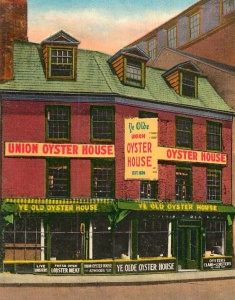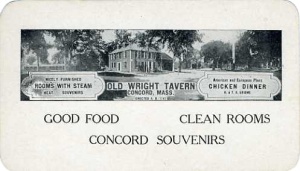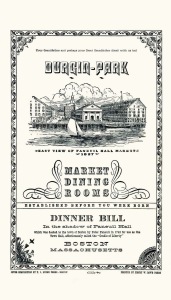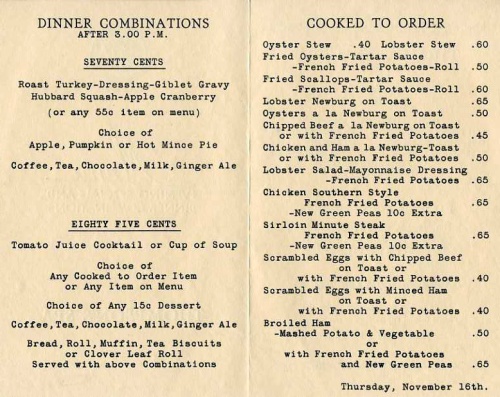
Although the U. S. population exceeded 12 million, only about 5% lived in the ten largest cities in 1830. Most Americans lived in sparsely populated areas where they rarely encountered restaurants — nor could they afford them.
Nonetheless, those who did patronize “restaurants” – then more likely to be called restorators, refectories, restaurats, eating houses, coffee houses, or victualing cellars – noticed a growing French influence grafted onto the predominant plain English style of cooking. The word “restaurant,” when used in this decade, usually had the modifier “French” preceding it.
To the relief of diners, it was becoming easier to find eating places that would serve dishes a la carte at the hour the diner wished to eat rather than having a pre-determined meal served only at set hours.
At most eating places the three F’s dominated menus: Fish, Flesh, and Fowl. And, of course, oysters were tremendously popular with all social classes. Occasionally, a restaurant offering a more varied bill of fare could be found, such as that at Robert G. Herring’s American Coffee House in Philadelphia that includes Green “Pease,” String Beans, Lobsters, Frogs, Sardines, Anchovy Toast, Omelet with Asparagus, and Strawberries and Cream.
Patrons of wealth and sophistication indulged in the finest foods that could be found in major cities such as New York, Philadelphia, and Boston. According to one observer, worldly young men were becoming knowledgeable about “culinary details” in the early 1830s. “It has become wonderfully fashionable lately in discoursing upon eatable matters,” wrote the author of A Short Chapter on Dining, “to parade the names of a dozen or two of French dishes.”
At the same time a spirit of abstemiousness was spreading as people rejected “ardent spirits” such as gin, rum, whiskey, and brandy. Temperance followers also condemned restaurants themselves, viewing most of them as “grog shops.” During the cholera pandemic of 1832, some temperance advocates went so far as to blame the high death rate among the poor not on urban filth and polluted drinking water, but on alcohol consumption, particularly by Irish immigrants.
In the larger cities, New York especially, many couples and families chose to live in hotels and boarding houses rather than run their own households, finding it both cheaper and easier. Others, who lived in their own residences, took their meals in nearby hotels or had them delivered by a restaurateur.
 Two English women who visited this country wrote scathing accounts of life here, painting Americans as shallow, grasping, and dull. In Frances Trollope’s Domestic Manners of the Americans, she observed how American conversation frequently included the word “dollar,” and also noted, “They consume an extraordinary quantity of bacon.” The actress Fanny Kemble’s Journal (1835) included among its “vituperative remarks” criticism of New York hotels and their rigid meal schedules.
Two English women who visited this country wrote scathing accounts of life here, painting Americans as shallow, grasping, and dull. In Frances Trollope’s Domestic Manners of the Americans, she observed how American conversation frequently included the word “dollar,” and also noted, “They consume an extraordinary quantity of bacon.” The actress Fanny Kemble’s Journal (1835) included among its “vituperative remarks” criticism of New York hotels and their rigid meal schedules.
As railroads and waterways were extended, newly settled areas of the country gained access to more oysters, seafood, and exotic fruits. In 1832 a traveler recorded that he ate “fine sea fish and oysters one hundred and fifty miles inland – drank punch from fruit imported from the Indies, at Pittsburg, and sat down to a dessert in Cincinnati, the ingredients of which were the delicacies of every clime.”
Highlights
1831 After visiting the dining room of the recently opened Tremont House in Boston, a Baltimore man writes that he finds it an “essential improvement in tavern keeping” that everyone dining there receives a bill of fare listing all dishes to be served at that meal. Otherwise, he comments, a diner departing from the dining hall usually discovers favorite dishes placed on another part of the long shared table that never made it to him.
1832 In Domestic Manners of the Americans, Frances Trollope asks why Americans are so fond of boarding in residential hotels: “What can induce so many . . . citizens to prefer these long, silent tables, scantily covered with morsels of fried ham, salt fish and liver, to a comfortable loaf of bread with their wives and children at home?” she writes.
 1833 Harvey D. Parker – who will establish the luxury Parker House and Restaurant in 1855 — takes over the Tremont Restorator in a cellar on Boston’s Court Street and publishes the protein-rich bill of fare shown here.
1833 Harvey D. Parker – who will establish the luxury Parker House and Restaurant in 1855 — takes over the Tremont Restorator in a cellar on Boston’s Court Street and publishes the protein-rich bill of fare shown here.
1833 The owner of a new refectory on Whale Street in Nantucket advertises that he will provide Pies, Tarts, Custards, Oysters, Fish Chowder, Hot Chocolate, Coffee, Mush & Milk, Beer, and Cider, but that he has promised his landlord he will “keep no ardent spirits of any description for sale” even though he knows it will mean lower profits.
1834 Francois Parrot, “French Cook, Restaurateur & Confectioner” in Philadelphia, announces “that after a long residence with the Count of Survilliers, he has, with recommendations from him for professional capacity and moral character (which he will be happy to shew any one), determined to set up a Cooking Establishment and Eating House in Philadelphia.”
 1835 The popular Alexander “Sandy” Welsh, president of the Hoboken Turtle Club and famous for his green turtle soup, expands his Terrapin Lunch in New York City and is now able to accommodate 150 seated in small groups.
1835 The popular Alexander “Sandy” Welsh, president of the Hoboken Turtle Club and famous for his green turtle soup, expands his Terrapin Lunch in New York City and is now able to accommodate 150 seated in small groups.
1836 After the opening of the Merchant’s Exchange Lunch on Broadway, a patron sends a glowing review to the editor of the New York Herald citing its fine cooking, clean tablecloths, damask napkins, excellent ventilation, and cheerful servers. “Only think,” he writes, “a plate of the best meat, including four kinds of vegetables, and the best butter also, in these dear times too, is only eighteen pence.”
1837 Following the destruction of their restaurant on William Street in the great fire of 1835, the Delmonico brothers open a new 4-story restaurant on the corner of Beaver and William Streets. [1880 photo shown at top, demolished 1890] Visitors are overwhelmed with its magnificence, particularly its wine vaults that extend 180 feet under the streets and hold 20,000 bottles of imported French and German wine. The restaurant’s resplendence is all the more striking as the city suffers bank failures, worthless currency, and economic depression.
1837 Outrage erupts when New Yorker Samuel E. Cornish, editor of The Colored American, discloses that he was refused service at a temperance eating house run by an abolitionist Scottish immigrant. Explaining that he has never before encountered discrimination of this sort, Cornish writes, “It remained for a foreigner, in a cellar cook-room, to insult a native citizen, of 17 years residence in this city; and to deny a minister of Christ, of gray hairs, and twenty-five years’ standing in the Presbyterian church, a cup of Tea.”
1837 As a result of economic collapse, businesses distrust paper money and refuse to give coins [aka “specie”] as change. When they do agree to accept bills they return change in the form of tickets good for future purchases. A patron of a NYC eating house becomes indignant when “a negro named Downing,” “a black villain,” refuses to accept his dollar bill. But the newspaper to which he has complained defends the proprietor, asking, “Why should any man be compelled to take worthless paper money for his goods and wares? When I visit Downing’s, I never give or take paper money. I pay in specie entirely.”

1839 At a “restaurat” in New Orleans, patrons attending summer balls are warned not to bring their guns.
© Jan Whitaker, 2018
























































 It's great to hear from readers and I take time to answer queries. I can't always find what you are looking for, but I do appreciate getting thank yous no matter what the outcome.
It's great to hear from readers and I take time to answer queries. I can't always find what you are looking for, but I do appreciate getting thank yous no matter what the outcome.


